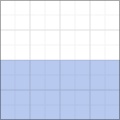|
ThreeDee
|
||||
| Posted: April 25, 2008 8:06 am | ||||
|
ThreeDee
|
Matrix, I don't know if I dare mention this, but there is actually a simpler way to do this:
Fraction 2.ffxml |
|||
| Posted: April 25, 2008 8:09 am | ||||
| matrix |
Ah, that is indeed a much simpler solution... I was actually going to update it with a third solution, but I think yours is even better: Fraction 3.ffxml |
|||
| Posted: April 25, 2008 11:07 am | ||||
| matrix |
I think the bias curve may still be useful though, if you want to actually find the reciprocal value of an integer in the range 1..100. Maybe I should post that as a separate snippet...
|
|||
| Posted: April 25, 2008 11:15 am | ||||
|
ThreeDee
|
Yes, there are definitely uses for the bias solution. You can actually use it to find reciprocal values in a range wider than 1-100, if you set the values differently. You'll have to move the decimal point before and after using the bias curve, but you can (fairly) easily extend it to calculate between, say, 0.01 and 10000. And there is a way to calculate the bias value. I recently figured it out graphically but I think it required integral calculus which I haven't done since high school, so I did the same as you and got the value by trial and error. I believe it was the same exact value that you got, too. |
|||
| Posted: April 25, 2008 4:38 pm | ||||
|
uberzev
|
||||
| Posted: April 25, 2008 5:35 pm | ||||
|
uberzev
|
Ok I was really bored and simplified ThreeDee's Fraction 2 a bit more. It renders a tad faster now.
fraction U.ffxml |
|||
| Posted: April 25, 2008 5:55 pm | ||||
|
ThreeDee
|
Game on. The first one that gets this down to two components is the winner.
(Well, it does still have to do the fraction...) fraction T.ffxml |
|||
| Posted: April 27, 2008 9:55 pm | ||||
|
ThreeDee
|
||||
| Posted: April 27, 2008 10:41 pm | ||||
|
ThreeDee
|
This one's so simple it's scary.
If I can lose the grid, it literally is TWO components. fraction W.ffxml |
|||
| Posted: April 27, 2008 10:57 pm | ||||
| matrix |
I wonder what is best in a performance perspective: using a tone curve and a linear curve or using the levels component. The levels component also needs to evaluate the gamma parameter, which might be expensive.
|
|||
| Posted: April 28, 2008 5:47 am | ||||
|
ThreeDee
|
I think you need to ask Master Vlad if the gamma parameter gets calculated even when it is linear. Of then you can stick enough of them in a row to bench test. I'm certainly nowhere near the stage of worrying about that difference myself. I'm usually worrying more about how to have less than 50 Offset Components in my filters, and whether the rendering is going to be finished the same day...
|
|||
| Posted: April 28, 2008 6:01 am | ||||
|
uberzev
|
|
|||
| Posted: April 28, 2008 12:44 pm | ||||
Join Our Community!
Filter Forge has a thriving, vibrant, knowledgeable user community. Feel free to join us and have fun!
33,767 Registered Users
+11 new in 30 days!
153,646 Posts
+32 new in 30 days!
15,366 Topics
+5 new in 30 days!
Online Users Last minute:
5 unregistered users.
Recent Forum Posts:
- Chaos Fields by Rachel Duim
January 4, 2026 - Suggest a new filter. by Rod Detmer
December 30, 2025 - Random Crashes using FF14 by PixelStar
December 29, 2025 - Is "snap to grid" actually working? by Raschid Abdul-Nour
December 26, 2025 - Minimalistic Patterns by Ramlyn by Ramlyn
December 25, 2025 - Circumball by Ramlyn by Ramlyn
December 25, 2025 - Affinity 3: Use size of single Artboard by Raschid Abdul-Nour
December 25, 2025 - How to declare your love by Djekki by SpaceRay
December 25, 2025 - Adaptive Tiling by byRo by SpaceRay
December 25, 2025 - Warning, be aware that Your unpowered SSD is a ticking time bomb by SpaceRay
December 25, 2025 - Happy Holidays! by SpaceRay
December 25, 2025 - Filter Forge 15 Released by Rod Detmer
December 24, 2025
